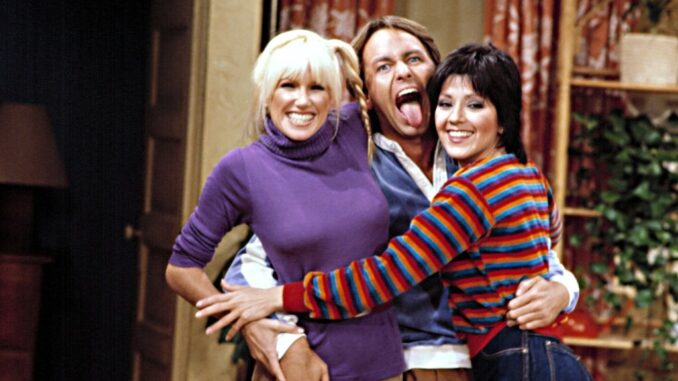
Introduction: A Show Ahead of Its Time
“Three’s Company” wasn’t just a sitcom; it was a pop culture phenomenon that redefined television comedy in the late ’70s and early ’80s. While its slapstick humor and loveable characters won audiences over, the backstage drama involving Suzanne Somers, one of the show’s breakout stars, introduced a layer of intrigue that fans still discuss today. One fascinating element? The show used special colored scripts whenever Suzanne Somers was on set. But why? Let’s dive into the juicy details behind this unique production choice.
H1: The Rise of ‘Three’s Company’ and Suzanne Somers
H2: How ‘Three’s Company’ Became a Household Name
In 1977, “Three’s Company” burst onto screens with its witty premise, revolving around three roommates navigating misunderstandings and hilarious mishaps. It quickly became a ratings juggernaut. Among the cast, Suzanne Somers, who played Chrissy Snow, stole the spotlight with her impeccable comedic timing and bubbly persona.
H2: Suzanne Somers: A Star in the Making
As Chrissy Snow, Somers embodied the quintessential “ditzy blonde,” but her charm went far beyond stereotypes. Her rising fame made her one of the most beloved TV personalities of the era. However, with stardom came tension—both on and off the set.
H1: The Backstage Tensions That Sparked the Script Drama
H2: Salary Disputes and the Birth of Colored Scripts
By the fifth season, Suzanne Somers demanded a significant pay increase, seeking parity with her male co-star, John Ritter. This bold move didn’t sit well with the producers, leading to a standoff. While Somers remained part of the show, her appearances were drastically reduced. To manage these changes, the production team began using colored scripts to accommodate her limited involvement.
H3: Why Colored Scripts?
Colored scripts weren’t just for aesthetic purposes—they served as a logistical tool. These scripts highlighted lines and scenes specifically written for Somers, ensuring her reduced presence didn’t disrupt the flow of the storyline. This strategy also kept the rest of the cast informed about the adjustments.
H1: The Fallout: Cast Dynamics and On-Set Challenges
H2: Strained Relationships Among Co-Stars
The decision to sideline Suzanne Somers created tension among the cast. While John Ritter and Joyce DeWitt carried the show’s weight, Somers’ reduced role highlighted the fractures within their camaraderie. Colored scripts became a symbol of division rather than unity.
H2: Audience Reaction to the Changes
Fans noticed Chrissy Snow’s diminishing presence, and ratings began to dip slightly. Despite the behind-the-scenes drama, “Three’s Company” managed to maintain its charm, but the colored script era marked a turning point for the beloved sitcom.
H1: The Significance of the Colored Script Era
H2: A Lesson in Hollywood Politics
The use of special colored scripts during Suzanne Somers’ tenure illustrates the complex dynamics of Hollywood production. From salary disputes to managing star power, the show’s producers had to adapt creatively to maintain harmony—or at least the illusion of it.
H3: An Iconic Footnote in Television History
Today, the story of “Three’s Company” and its colored scripts serves as a fascinating example of how off-screen decisions can impact on-screen storytelling. It’s a reminder that even the most beloved shows are shaped by the human dynamics behind the scenes.
H1: How ‘Three’s Company’ Influences Modern Television
H2: The Legacy of Suzanne Somers
Though her time on “Three’s Company” ended on a controversial note, Suzanne Somers went on to achieve significant success in other ventures. Her story continues to inspire discussions about gender equity and fair pay in Hollywood.
H2: Innovations in Production Management
The colored scripts introduced during Somers’ tenure are now seen as a clever, albeit unconventional, solution to cast scheduling challenges. Such strategies paved the way for modern TV shows to handle similar issues seamlessly.
H1: Conclusion: Why This Story Still Matters
The tale of “Three’s Company” and its unique colored scripts goes beyond mere trivia. It’s a story of ambition, conflict, and adaptation—a microcosm of the entertainment industry itself. Suzanne Somers’ journey reminds us of the ongoing struggle for equality and recognition, while the show’s creative solutions highlight the ingenuity that keeps television ticking.
FAQs
1. Why did ‘Three’s Company’ use special colored scripts?
The colored scripts were used to manage Suzanne Somers’ reduced appearances due to her salary disputes with the producers. They ensured smooth production while accommodating her limited role.
2. Did the colored scripts affect the show’s quality?
While they created logistical challenges, the overall quality of the show remained high. However, fans did notice Chrissy Snow’s diminished presence.
3. Was Suzanne Somers fired from ‘Three’s Company’?
Not exactly. While her role was significantly reduced due to contractual disagreements, she eventually left the show after the fifth season.
4. What impact did Suzanne Somers have on the show’s legacy?
Suzanne Somers remains one of the most iconic characters of “Three’s Company.” Her story sparked conversations about fair pay and gender equality in Hollywood.
5. How is ‘Three’s Company’ remembered today?
“Three’s Company” is celebrated as a classic sitcom that redefined comedy and tackled real-world issues with humor and heart. Its behind-the-scenes stories only add to its legacy.
